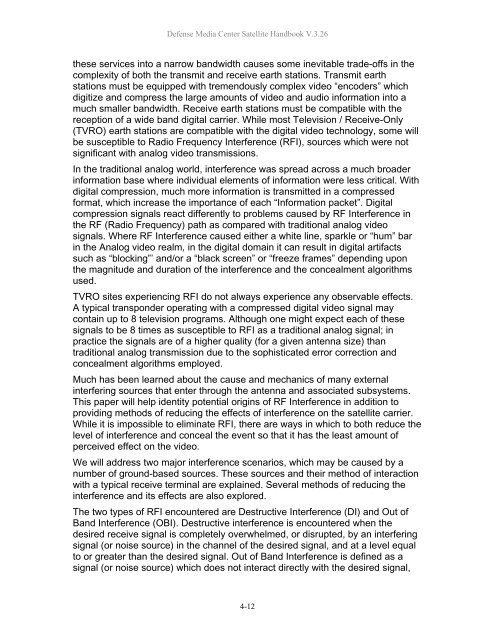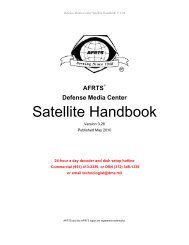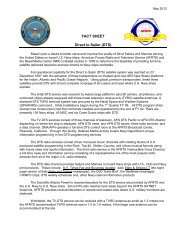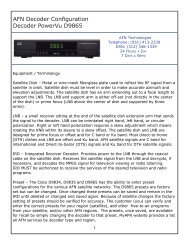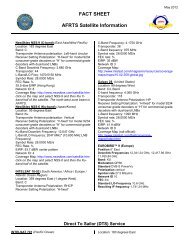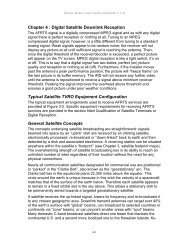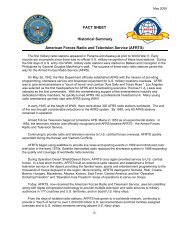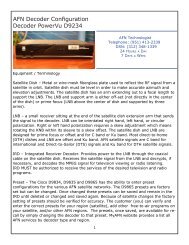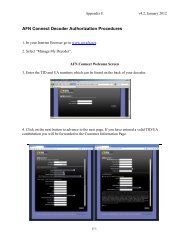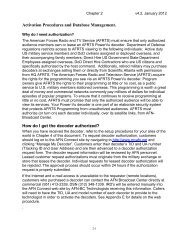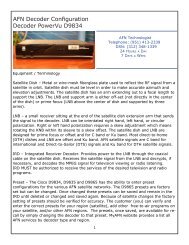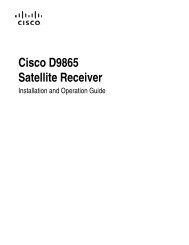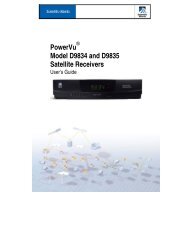AFRTS Defense Media Center Satellite Handbook
AFRTS Defense Media Center Satellite Handbook
AFRTS Defense Media Center Satellite Handbook
Create successful ePaper yourself
Turn your PDF publications into a flip-book with our unique Google optimized e-Paper software.
<strong>Defense</strong> <strong>Media</strong> <strong>Center</strong> <strong>Satellite</strong> <strong>Handbook</strong> V.3.26<br />
these services into a narrow bandwidth causes some inevitable trade-offs in the<br />
complexity of both the transmit and receive earth stations. Transmit earth<br />
stations must be equipped with tremendously complex video “encoders” which<br />
digitize and compress the large amounts of video and audio information into a<br />
much smaller bandwidth. Receive earth stations must be compatible with the<br />
reception of a wide band digital carrier. While most Television / Receive-Only<br />
(TVRO) earth stations are compatible with the digital video technology, some will<br />
be susceptible to Radio Frequency Interference (RFI), sources which were not<br />
significant with analog video transmissions.<br />
In the traditional analog world, interference was spread across a much broader<br />
information base where individual elements of information were less critical. With<br />
digital compression, much more information is transmitted in a compressed<br />
format, which increase the importance of each “Information packet”. Digital<br />
compression signals react differently to problems caused by RF Interference in<br />
the RF (Radio Frequency) path as compared with traditional analog video<br />
signals. Where RF Interference caused either a white line, sparkle or “hum” bar<br />
in the Analog video realm, in the digital domain it can result in digital artifacts<br />
such as “blocking”’ and/or a “black screen” or “freeze frames” depending upon<br />
the magnitude and duration of the interference and the concealment algorithms<br />
used.<br />
TVRO sites experiencing RFI do not always experience any observable effects.<br />
A typical transponder operating with a compressed digital video signal may<br />
contain up to 8 television programs. Although one might expect each of these<br />
signals to be 8 times as susceptible to RFI as a traditional analog signal; in<br />
practice the signals are of a higher quality (for a given antenna size) than<br />
traditional analog transmission due to the sophisticated error correction and<br />
concealment algorithms employed.<br />
Much has been learned about the cause and mechanics of many external<br />
interfering sources that enter through the antenna and associated subsystems.<br />
This paper will help identity potential origins of RF Interference in addition to<br />
providing methods of reducing the effects of interference on the satellite carrier.<br />
While it is impossible to eliminate RFI, there are ways in which to both reduce the<br />
level of interference and conceal the event so that it has the least amount of<br />
perceived effect on the video.<br />
We will address two major interference scenarios, which may be caused by a<br />
number of ground-based sources. These sources and their method of interaction<br />
with a typical receive terminal are explained. Several methods of reducing the<br />
interference and its effects are also explored.<br />
The two types of RFI encountered are Destructive Interference (DI) and Out of<br />
Band Interference (OBI). Destructive interference is encountered when the<br />
desired receive signal is completely overwhelmed, or disrupted, by an interfering<br />
signal (or noise source) in the channel of the desired signal, and at a level equal<br />
to or greater than the desired signal. Out of Band Interference is defined as a<br />
signal (or noise source) which does not interact directly with the desired signal,<br />
4-12


